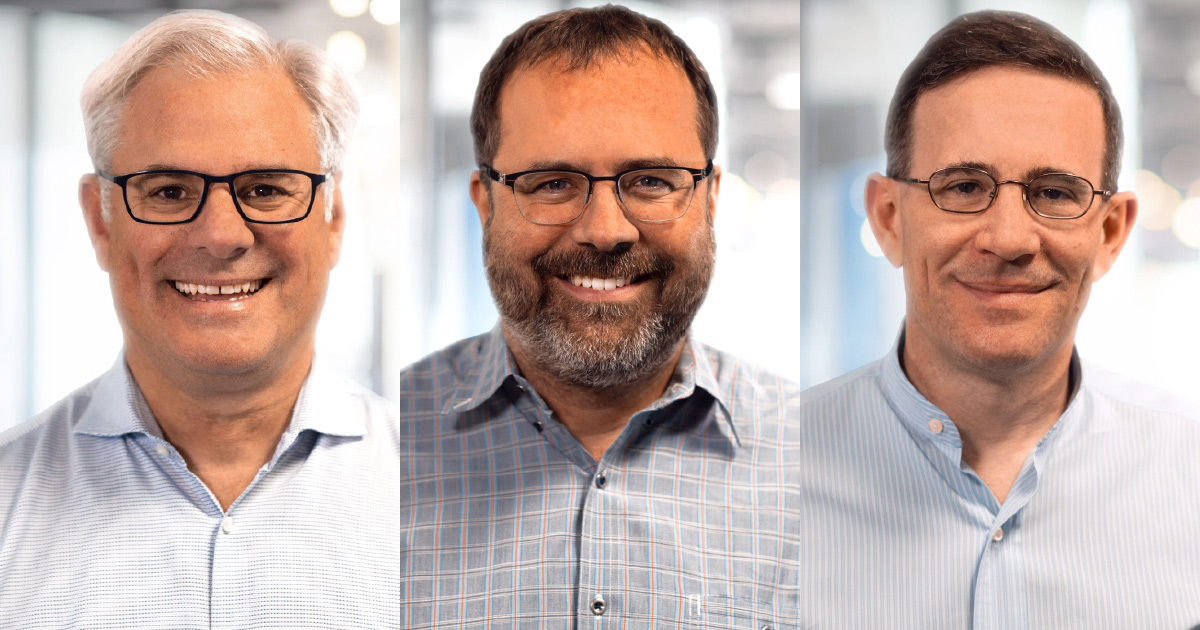While working at Microsoft, Robert Wahbe, our CEO; Oliver Sharp, our Chief Solution Architect; and David Wortendyke, our Chief Product Officer, uncovered an urgent need for technology that could empower customer-facing teams to do their best work — and make the most of every buyer interaction. So they set out to build it. And thus, Highspot was born.
Today, we’re taking a step back to follow Highspot’s journey from an idea to an award-winning company. Here’s the story of how our founders built Highspot.
How did the three of you meet?
Robert Wahbe: We have known each other for a very long time, through grad school and our tenure at Microsoft. When I was looking to build what would eventually become Highspot, both Oliver and David immediately came to mind.
Oliver Sharp: Robert and I got to know each other about thirty years ago when we were graduate students at UC Berkeley. Together with one other person, we started a company that was eventually acquired by Microsoft, and we’ve more or less worked together ever since.
David Wortendyke: Robert, Oliver, and I met in 2000. I joined a small team with them inside of Microsoft. I remember being impressed by their work ethic and their open personalities. I knew then that I wanted to keep working with them and keep building great things together.
Where did the idea for Highspot come from?
Robert: Highspot was born out of the challenges of enabling large, complex, customer-facing teams. Towards the end of my career at Microsoft, I was running a large marketing organization — we were producing lots of marketing materials and focused on helping the sales team do their jobs.
But when we would speak to sales about our programs and materials, it was clear that they either hadn’t heard of them or had heard of them but weren’t using them. It was a really eye-opening experience. And it showed us just how hard it was for marketing, sales, and services to work together effectively.
That got us thinking: how could technology help? We believed — and still believe — that by combining the modern user experience of popular consumer applications with AI and cloud computing that we could empower customer-facing teams to work more efficiently and effectively.
Why enablement?
Oliver: A salesperson’s life is busy; they don’t have hours to sift through hundreds of assets to find what they need. They have seconds. But the tools given to them to discover content are often terrible.
Just imagine that you’re a rep at a major enterprise. You probably have thousands of unique products you could sell. For each product, there are hundreds of pieces of content you might need — customer decks, demos, instruction manuals, training materials, brochures. To find a particular asset, most salespeople email their friends to see if anyone has it. That’s not an effective method of searching — or selling.
With these challenges in mind, the initial goal of a tool like Highspot is to make these many thousands of items instantly available right when you need it so you can go into a conversation and get the right message to your customer.
What were the early days of Highspot like?
David: I remember making trips to Ikea, picking out desks and couches, getting them to our office, and getting our furniture set up. That experience — of literally building our office ourselves — is really representative of what the early days of Highspot were for me.
At any point, no matter what the challenge was, you had to dig in and find a solution. There was a willingness in everyone to roll up their sleeves and make it happen.
What’s one thing that makes Highspot unique?
Oliver: We take a pretty unusual approach to our customers. Other companies say they love their customers. They will mean it, but they don’t always invest in their relationship with their customers the way we have.
We aim to transcend the vendor relationship; we want our customers to see us as a part of their teams — not just a vendor that keeps them at arm’s length.
By being willing to get in the mud and wrestle with their problems, we were able to not only find new ways of delighting our users but also to discover where we fell short. We learned what was hard. We learned where we had to do better. The evolution of our product has been shaped by that struggle and what we learned in that crucible. Ultimately, it helped us build a better product for our customers.
How do you build a product that delights customers?
David: We have a really strong, positive, respectful relationship with our services team — which is important because this team works closely with our customers. They know their pain points.
We work to make sure that Services gets to have a voice in the things that we are doing and the decisions that we are making. That relationship allows us to be grounded in what we build so that it truly reflects what our customers need.
In one word, how would you describe the future of Highspot?
Robert: If I had to describe Highspot with one word eight years ago, when we were working out of a rental house, I would say dynamic. If I had to describe Highspot today, I would still say dynamic. Because it has been and will be a constant evolution.
In the early days, it was dynamic because we were learning so much, literally defining the category. But eight years later, I find that that word still applies because our customers are always changing: How they work, how they are transforming, how they are trying to meet the needs of their customers. Our goal is to continue to meet and support our customers throughout this incredible journey we’re taking together.
Inventing the Future Every Day
From day one, our founders have been laser-focused on transforming the way millions of people work. Feeling inspired by their journey? Join our team — and invent the future with us.




